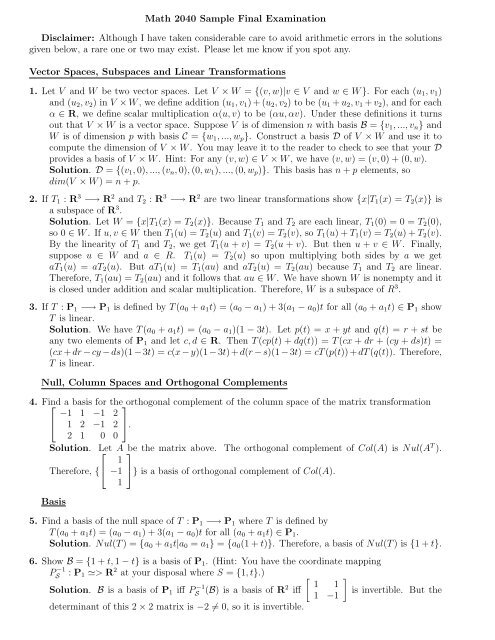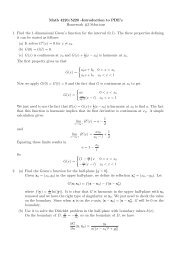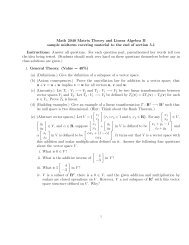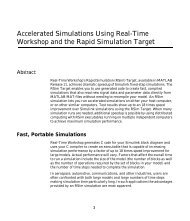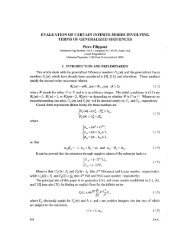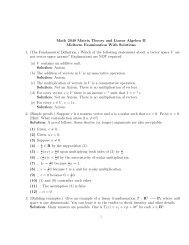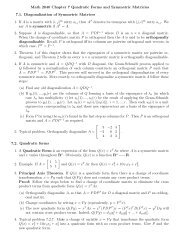Math 2040 Sample Final Examination Disclaimer: Although I have ...
Math 2040 Sample Final Examination Disclaimer: Although I have ...
Math 2040 Sample Final Examination Disclaimer: Although I have ...
Create successful ePaper yourself
Turn your PDF publications into a flip-book with our unique Google optimized e-Paper software.
<strong>Math</strong> <strong>2040</strong> <strong>Sample</strong> <strong>Final</strong> <strong>Examination</strong><strong>Disclaimer</strong>: <strong>Although</strong> I <strong>have</strong> taken considerable care to avoid arithmetic errors in the solutionsgiven below, a rare one or two may exist. Please let me know if you spot any.Vector Spaces, Subspaces and Linear Transformations1. Let V and W be two vector spaces. Let V × W = {(v, w)|v ∈ V and w ∈ W }. For each (u 1 , v 1 )and (u 2 , v 2 ) in V × W , we define addition (u 1 , v 1 ) + (u 2 , v 2 ) to be (u 1 + u 2 , v 1 + v 2 ), and for eachα ∈ R, we define scalar multiplication α(u, v) to be (αu, αv). Under these definitions it turnsout that V × W is a vector space. Suppose V is of dimension n with basis B = {v 1 , ..., v n } andW is of dimension p with basis C = {w 1 , ..., w p }. Construct a basis D of V × W and use it tocompute the dimension of V × W . You may leave it to the reader to check to see that your Dprovides a basis of V × W . Hint: For any (v, w) ∈ V × W , we <strong>have</strong> (v, w) = (v, 0) + (0, w).Solution. D = {(v 1 , 0), ..., (v n , 0), (0, w 1 ), ..., (0, w p )}. This basis has n + p elements, sodim(V × W ) = n + p.2. If T 1 : R 3 −→ R 2 and T 2 : R 3 −→ R 2 are two linear transformations show {x|T 1 (x) = T 2 (x)} isa subspace of R 3 .Solution. Let W = {x|T 1 (x) = T 2 (x)}. Because T 1 and T 2 are each linear, T 1 (0) = 0 = T 2 (0),so 0 ∈ W . If u, v ∈ W then T 1 (u) = T 2 (u) and T 1 (v) = T 2 (v), so T 1 (u) + T 1 (v) = T 2 (u) + T 2 (v).By the linearity of T 1 and T 2 , we get T 1 (u + v) = T 2 (u + v). But then u + v ∈ W . <strong>Final</strong>ly,suppose u ∈ W and a ∈ R. T 1 (u) = T 2 (u) so upon multiplying both sides by a we getaT 1 (u) = aT 2 (u). But aT 1 (u) = T 1 (au) and aT 2 (u) = T 2 (au) because T 1 and T 2 are linear.Therefore, T 1 (au) = T 2 (au) and it follows that au ∈ W . We <strong>have</strong> shown W is nonempty and itis closed under addition and scalar multiplication. Therefore, W is a subspace of R 3 .3. If T : P 1 −→ P 1 is defined by T (a 0 + a 1 t) = (a 0 − a 1 ) + 3(a 1 − a 0 )t for all (a 0 + a 1 t) ∈ P 1 showT is linear.Solution. We <strong>have</strong> T (a 0 + a 1 t) = (a 0 − a 1 )(1 − 3t). Let p(t) = x + yt and q(t) = r + st beany two elements of P 1 and let c, d ∈ R. Then T (cp(t) + dq(t)) = T (cx + dr + (cy + ds)t) =(cx + dr − cy − ds)(1 − 3t) = c(x − y)(1 − 3t) + d(r − s)(1 − 3t) = cT (p(t)) + dT (q(t)). Therefore,T is linear.Null, Column Spaces and Orthogonal Complements4. Find ⎡ a basis for the⎤orthogonal complement of the column space of the matrix transformation−1 1 −1 2⎣ 1 2 −1 2 ⎦.2 1 0 0Solution. Let ⎡ A be the matrix above. The orthogonal complement of Col(A) is Nul(A T ).Therefore, { ⎣ 1⎤−1 ⎦} is a basis of orthogonal complement of Col(A).1Basis5. Find a basis of the null space of T : P 1 −→ P 1 where T is defined byT (a 0 + a 1 t) = (a 0 − a 1 ) + 3(a 1 − a 0 )t for all (a 0 + a 1 t) ∈ P 1 .Solution. Nul(T ) = {a 0 + a 1 t|a 0 = a 1 } = {a 0 (1 + t)}. Therefore, a basis of Nul(T ) is {1 + t}.6. Show B = {1 + t, 1 − t} is a basis of P 1 . (Hint: You <strong>have</strong> the coordinate mappingP −1S: P 1 ≃> R 2 at your disposal where S = {1, t}.) [ ]1 1Solution. B is a basis of P 1 iff P −1S(B) is a basis of R2 iffis invertible. But the1 −1determinant of this 2 × 2 matrix is −2 ≠ 0, so it is invertible.
Change of Coordinates7. Find the change of coordinate [ matrix ] [ on]R 2 from B represented vectors to C[ represented ] [ ] vectors1 1 2 3if B is the ordered basis { , } of R−1 12 and C is the ordered basis { , } of R3 22 .[ ] [ ]Solution. P C←B = P −1C P B = − 1 2 −3 1 1= ...5 −3 2 −1 18. Suppose B = {b 1 , b 2 } is an ordered basis of P 1 . Let P S←B be the change of coordinate matrixfrom B represented [ ] [ vectors ] to vectors [ represented ] [ by]the standard basis S = {1, t} of P 1 . Find1 4 1 2B if P S←B = and P1 2S←B = .−1 −2] [ ][ ]11+ )) =−11P 2 S(P S←B +1[1Solution. We <strong>have</strong> b 1 = P B e 1 = P S P S←B e 1 = P S P S←B ( 1( 2 1[ ] [ ] [ ] [ ]14P S←B ) =−11P 262 S( + ) =2 −21P 2 S = 3 + 0t.0] [−[1Also, b 2 = P B e 2 = P S P S←B e 2 = P S P S←B ( 1( 2 1] [ ] [ ]1 4 P 222 S([− ) =2 −21P 2 S = 1 + 2t.4Representations of Linear Transformations1−1])) = 1 2 P S(P S←B[11]−P S←B[9. Find the representation [T ] S : R 2 −→ R 2 of T : P 1 −→ P 1 where T is defined by T (a 0 + a 1 t) =(a 0 − a 1 ) + 3(a 1 −[a 0 )t for all ](a 0 + a 1 t) ∈ P 1 and where S = {1, t} is the standard basis of P 1 .1 −1Solution. [T ] S =.−3 310. Let B = {1 − t, 1 + t}. It is an ordered basis of P 1 . Find the representation [T ] B of the lineartransformation T : P 1 → P 1 defined by P (α + βt) = (α + β) + αt.Solution. [T ] B e 1 = P −1B T P Be 1 = P −1−1−1BT (1[− t) =]PB(t) = PB ( 1 ((1 + t) − (1 − t))) =21 −1−1−1/2(P2 B(1 + t) − PB (1 − t)) = 1(e 2 2 − e 1 ) = . [T ]1/2 B e 2 = P −1BT P Be 2 = P −1BT (1 + t) =[ ][ ]P −1−1−1−1 −1/2−1/2B(2 + t) = PB(2) + PB(t) = PB (2) + = P1/2−1B ((1 + t) + (1 − t)) + =1/2[ ] [ ][ ]−1/2 1/2−1/2 1/2e 2 + e 1 + = . Therefore, [T ]1/2 3/2B =.1/2 3/2Eigenvalues and Eigenvectors11. In each case, find a basis B of R 2 such that [A] B is diagonal or is the representation of a complexmultiplication. [ In each ] case, compute [ P and ][T ] B such that A = P [T ] B P −1 .1 −31 5(a) A =, and (b) A = .−3 9−2 3Solution.(a) The characteristic polynomial is[ A −]λI 2 = −λ(10 −[λ) so]the eigenvalues are 0 and 10.3 1Corresponding eigenvectors are for λ = 0 and for λ = 10. Therefore, A =1−3[ ] [ ] [ ] [ ]0 03 13P DP T 1where D = [T ] B = and P = . B = { , }.0 101 −31 −3(b) |A − λI 2 | = (1 − λ)(3 − λ) + 10 = λ 2 − 4λ + 13 so the eigenvalues are λ = 2 ± 3i. Fixλ = 2 + 3i. The second row[ of A − λI 2 is [−2 1 + 3i] so a complex eigenvector corresponding1] [ 3][ 1] [ 3]to λ = 2 − 3i is u + vi = 2 + 2 i. Therefore, if we set B = { 2 , 2 } then1 0 1 0[ ]2 −3[A] B =represents A as complex multiplication by 2 + 3i.1−1]) =


